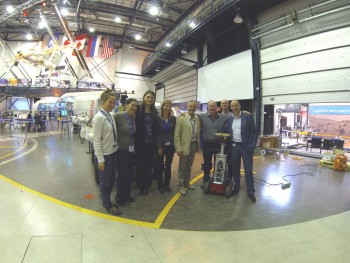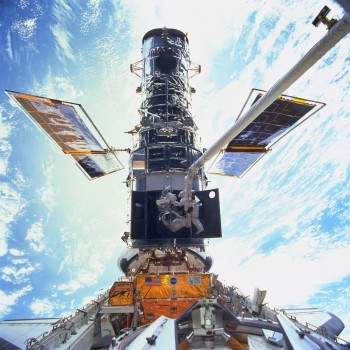
Marina Rantanen, Andrea Boyd, Jessica Grenouilleau, Deana Smith, J-F, Bill Carey, Cris Englert and Philippe Schoonejans around the rover that will provide ESA astronaut Andreas Mogensen with video of Eurobot during the experiment this summer. Credits: Jean-Francois Clervoy
A crucial part of controlling a rover is interacting with its user interface. The interface should provide the operator with all the information and controls necessary to perform the tasks that lie ahead. What that information actually encompasses is not always obvious however, and the question is: is it at all possible to provide an accurate sense of driving something that is thousands of kilometres away using only a computer screen. We have tried a number of interfaces for Eurobot throughout the years that each marked a milestone in the development of a truly comprehensive remote control and situational awareness system. We are now taking another step closer to that goal with Thales Alenia Space Italy and ESA astronauts Frank De Winne and Jean-Francois Clervoy.
It is one thing for an operator on ground, that can see and hear the rover to use an on-screen, graphical interface, but a different story for someone on board the International Space Station to do the same. To help us understand the needs of an astronaut in space, we received support from Frank De Winne and Jean-Francois Clervoy. As both Frank and Jean-Francois are experienced test pilots that have flown on several space missions, they brought a very important perspective to Meteron. We held workshops with them to help us understand how the end-user thinks and how they interact with the rover. They showed us first-hand how information on the display was interpreted and how they then reacted to the information.

ESA astronaut Jean-Francois Clervoy on one of his last spacewalks for the Hubble telescope. Credits: NASA
It is important to keep in mind that people are very similar on many points, but different on many others. Creating a Graphical User Interface (GUI) that is intuitive in a very broad sense is key, as it is not realistic to cater to everyone’s specific preference. The system should also be generic as new rovers and other robotic assets could be controlled from the same work station in the future. So what does an astronaut expect from a rover control-station? Both Frank and Jean-Francois emphasised the need for a quick overview of what they can control and their states. The interface ultimately needs to give the operator confidence to perform requested tasks and provide reliable real-time feedback. Graphical representations of reality will generally convey information faster than text, and common solutions for any added feature should always be implemented.
Who would not be inspired working on a new type of Android, Windows or iOS user interface specifically for space? We definitely are!
Marina Rantanen, Eurobot Engineer


Discussion: no comments